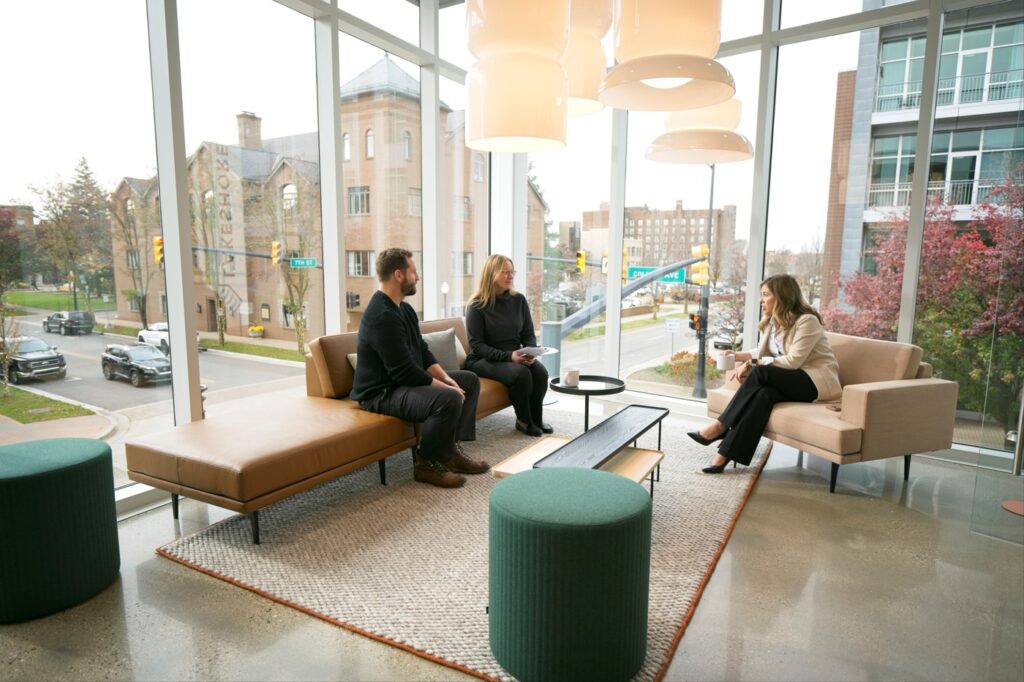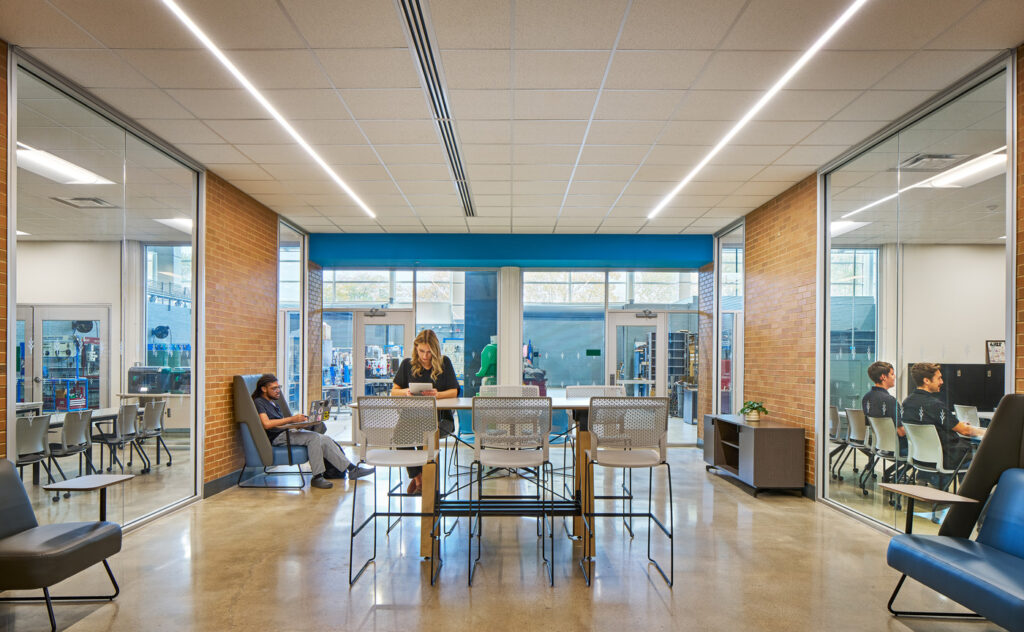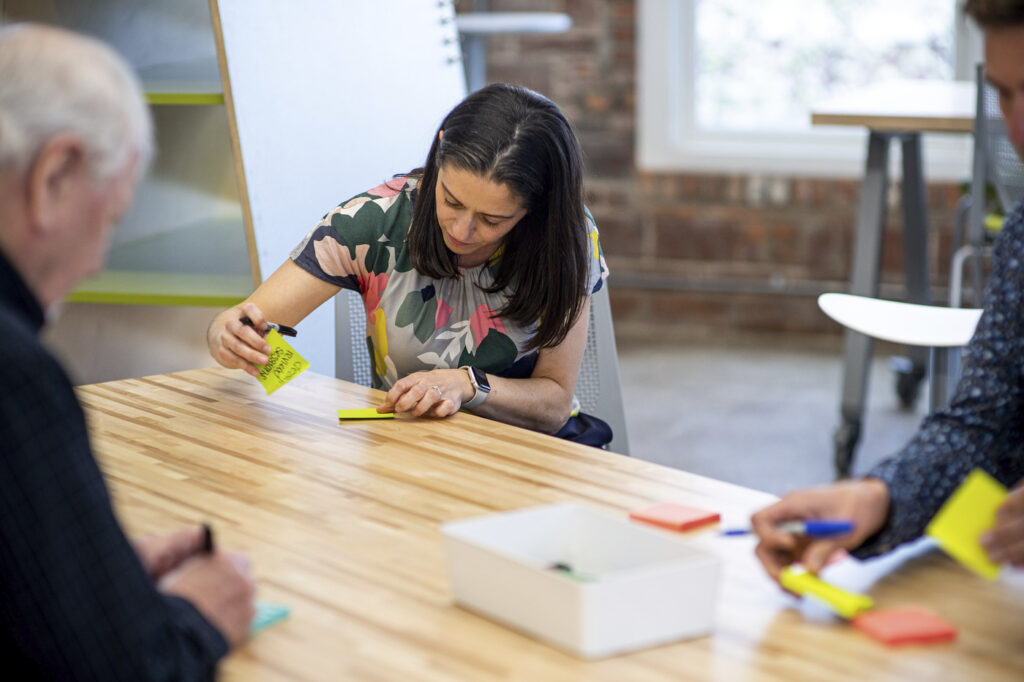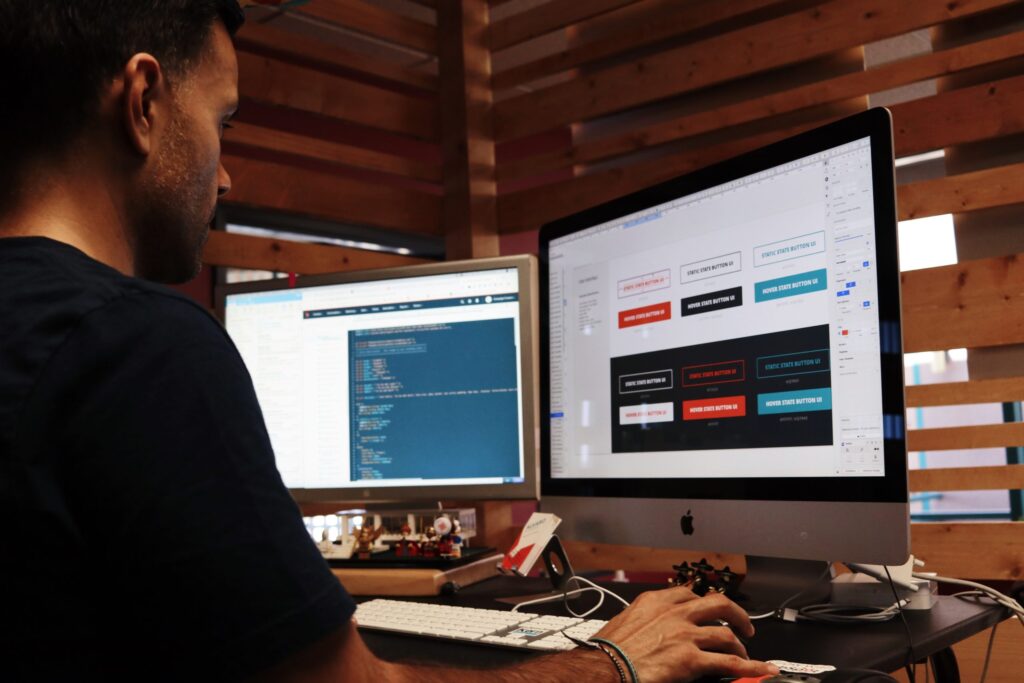The post Beyond Brochures: Using Design to Increase Student Engagement in Higher Education appeared first on GMB.
]]>Higher education institutions are in a constant battle to attract and retain students. With the proliferation of online learning and the increased competition among colleges and universities, engagement has become a key factor in ensuring the success of higher education institutions. One of the ways to achieve this is through effective creative design, which plays a crucial role in creating engaging and effective communication materials for higher education institutions.
Here are some creative points to consider when seeking to increase engagement in the higher ed space.
Visual Appeal
Your institution’s website, social media profiles, and promotional materials should be visually appealing, so always use high-quality images and color schemes that align with your institution’s branding. The use of relevant visuals and graphics can help convey information more effectively and make the content more attractive to students.
Typography also plays a significant role in communicating your institution’s brand message. Using the right typeface, size, and color can create a visual hierarchy that guides the viewer’s eye and communicates the information effectively. Choose typefaces that are easy to read and align with your brand’s personality.
Infographics are also an effective way to present complex information in a visually appealing and easily digestible format. Infographics can be used to illustrate statistics, explain concepts, and showcase research findings. When designing an infographic, consider using a mix of charts, icons, illustrations, and typography to create a visually engaging and informative piece.
And remember that consistency in branding across all communication materials is essential in establishing a strong brand identity. Using consistent color schemes, typography, and design elements in all marketing materials creates a cohesive brand message and reinforces the institution’s brand identity, making it more memorable for prospective and current students.

Interactive and Responsive Design
Interactive design is a great way to increase engagement among students. Incorporate features such as quizzes, polls, and surveys into your website and social media to encourage students to interact with your institution. It also helps you gather valuable feedback that can be used to improve the quality of your programs and services.
A responsive approach to web design optimizes websites for different devices, such as mobile, desktop, and tablets. By using responsive design, you can ensure that your website is easy to use and navigate, regardless of the device that the user is using. This is particularly important in higher education, where students often access course materials and other information on the go.
Social Media Presence
Social media is a powerful tool for engaging students. Your institution’s social media profiles should be designed to reflect your branding and should be updated regularly with engaging and informative content.
Consider hosting social media contests or challenges that encourage students to participate and share their experiences with your institution.
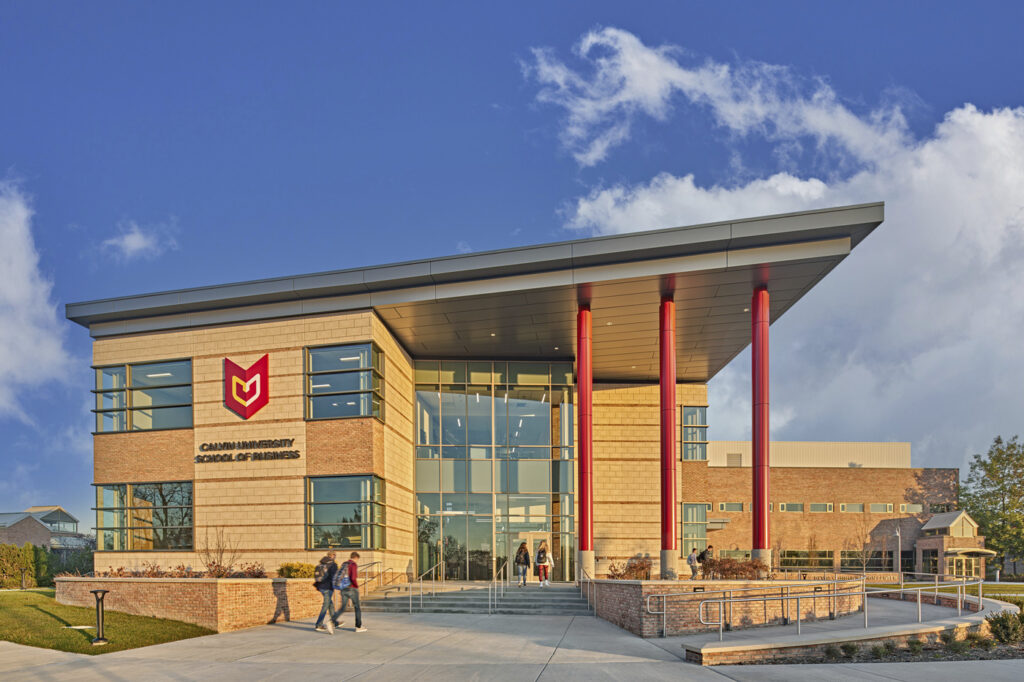
Consistency Across Campus
At GMB, we’re challenged with creating learning environments where students, staff, visitors, and faculty can balance both their virtual and physical worlds. As the higher education experience becomes increasingly hybrid—merging virtual and in-person learning, accommodating both resident and commuter students, and fostering cross-disciplinary collaboration—it’s essential to consider the entire student journey. From the moment students are first introduced to your institution, through every touchpoint on campus, a cohesive and consistent design strategy is key. By aligning every aspect of your campus planning with a unified vision, colleges and universities can create spaces that not only function efficiently but also embody your institution’s brand, fostering a seamless experience that supports student engagement at every level.
Incorporation of Multimedia
Incorporating multimedia elements such as videos, animations, and podcasts can increase engagement among students and make learning more interactive and engaging. Multimedia elements can be used to explain complex concepts or to showcase student work, making it more memorable and effective.
Gamification
Gamification is the process of adding game-like elements to non-game contexts. Incorporating gamification into your website or social media profiles can be a great way to increase engagement. Consider adding elements such as leaderboards, badges, and rewards for completing certain tasks or milestones.
Overall, creative design is an essential aspect of engaging students in higher education. By implementing the strategies above, you can make your institution more appealing to potential students, and you can increase engagement among your current students. Remember to keep your design consistent with your branding and regularly update your website and social media profiles with fresh content.
Related Insights
Tags
The post Beyond Brochures: Using Design to Increase Student Engagement in Higher Education appeared first on GMB.
]]>The post Elevating Higher Education: Strategic Collaboration in Brand, Web, and Digital Projects appeared first on GMB.
]]>Best Practices for Working with Higher Education Projects
In the fast-evolving landscape of higher education, universities and colleges face the constant challenge of staying relevant and engaging with their audience. In an era dominated by digital platforms, a strong online presence is not just desirable, but imperative.
Success lies not only in creative brilliance, but also in strategic collaboration with various departments during brand, web, and digital projects.
The Importance of Holistic Collaboration
Effective collaboration is the cornerstone of successful projects. In the context of higher education, where institutions are multifaceted with diverse academic departments, administrative units, and student services, it’s crucial to bring in the right stakeholders from the outset. A holistic approach ensures that the brand, web, or digital project aligns seamlessly with the institution’s goals, values, and unique identity.
1. Bringing Academia into the Fold
When embarking on a branding journey for a higher education client, involving academic departments is paramount. These departments are the backbone of the institution, each contributing to its distinct academic flavor.
Collaborate with faculty and department heads to understand the unique selling points of their programs, research achievements, and educational philosophies. Incorporating these insights into the branding strategy ensures a genuine representation of the institution’s academic excellence.
2. Navigating the Administrative Landscape
Administrative units play a crucial role in shaping the overall university experience. Admissions, student affairs, and alumni relations are key areas that can significantly impact brand perception.
By collaborating closely with these departments, advertising agencies can tailor strategies that resonate with prospective students, streamline the admissions process, enhance student life, and foster a strong sense of community. Administrative collaboration is particularly crucial in digital projects like website development where user experience is paramount.
3. Student-Centric Digital Initiatives
In the digital age, a university’s website is often the first point of contact for prospective students. Ensuring a seamless and engaging online experience requires collaboration not only with the IT department, but also with student representatives.
Conduct focus groups, gather feedback, and involve students in the decision-making process to create a website that reflects their needs, expectations, and aspirations. This collaborative approach not only enhances the digital presence, but also fosters a sense of ownership among the student community.
The Power of Cross-Functional Teams
Successful teams recognize that cross-functional teams are the key to unlocking the full potential of higher education projects. By bringing together experts from design, marketing, technology, academia, and administration, a comprehensive understanding of the institution is developed.
This holistic perspective not only leads to more effective brand communication, but also ensures that the website and digital initiatives align seamlessly with the institution’s overall vision.
Conclusion
In the realm of higher education advertising, success is not just about creating eye-catching visuals or implementing cutting-edge technologies. It’s about understanding the institution’s DNA and weaving it into every aspect of the brand, web, and digital projects.
Strategic collaboration with academic departments, administrative units, and student representatives ensures that advertising agencies deliver campaigns that resonate deeply with the target audience. By working hand-in-hand with the diverse stakeholders within a higher education institution, advertising agencies can elevate their projects from mere campaigns to transformative experiences that we can collaborate with you and your university team today.
Related Insights
Tags
The post Elevating Higher Education: Strategic Collaboration in Brand, Web, and Digital Projects appeared first on GMB.
]]>The post Best Design Practices for Higher Education Websites appeared first on GMB.
]]>In today’s digital age, websites have become the face of higher education institutions for many prospective and current students, faculty, and alumni. It’s essential for universities and colleges to have a website that is not only functional, but also visually appealing. Good higher ed website design is crucial for many reasons, including creating a positive user experience, building a solid brand identity, and improving conversion rates. A well-designed website will also bring your brand’s mission, values, and messaging to life for its users.
What are some best practices to follow when designing or redesigning a higher ed website? For starters, focusing on a few core foundations, such as user-centered design, storytelling, web accessibility, and mobile responsiveness, will all contribute to a more engaging user experience.
User-Centered Design
As the digital landscape continues to grow, user experience (UX) has become a vital aspect of website design. It’s no longer enough to simply create a website that looks good. To be successful, websites must be easy to use, intuitive, and meet the needs of the people who use them. That’s where user-centered design comes in.
Storytelling
With so many higher education websites out there, it can be difficult to stand out. Storytelling is a powerful tool that can make your higher ed website design more engaging and memorable.
Incorporating storytelling into your website’s design can create an emotional connection with your audience, build trust, and communicate your brand message in a way that is both entertaining and informative.
By telling a unique and engaging story through visual design, photography, and copywriting, you can set your higher ed brand apart from the competition and create a strong impression with your audience.
User-centered design is a design approach that puts the needs and wants of users at the forefront of the design process. It takes into account the users’ goals, motivations, and behaviors to create a website that is tailored to their needs. Prioritizing the user experience will ensure that your site is easy to navigate and understand, providing a more satisfying and enjoyable experience for users, which makes it more likely they will stay on the site longer and engage with it more.
Accessible Web Content
The Web Content Accessibility Guidelines (WCAG) are a set of internationally recognized guidelines for making websites accessible to people with disabilities. It includes areas like color contrast, functional images, and font usage hierarchies. By following these guidelines, you can ensure that your website is usable and accessible to a wider audience, which can improve the user experience for everyone who visits your site.
An additional benefit of following WCAG is that it improves your website’s Search Engine Optimization (SEO). Websites that are accessible to people with disabilities are often easier for search engines to crawl and index. This means that your website may be more likely to appear at the top of search engine results, which can help you reach more potential visitors.
Mobile-Responsive Strategy
With the increasing number of people using mobile devices to browse the web, a higher ed website design that is mobile-responsive has become a necessity for higher education sites.
A responsive website is designed to adjust its layout and content to the size of the user’s screen, providing an optimal viewing and navigation experience on any device. Wise design strategies for all page elements, such as responsive grids, font sizes, fluid images, and device breakpoints, are critical parts of the design process.
There are numerous benefits to using an effective mobile-responsive strategy with your higher education website, including an improved user experience, increased reach, and better SEO and conversion rates.
In Conclusion
Incorporating user-centered design, storytelling, web accessibility, and mobile responsiveness into higher ed website design creates a valuable investment for any higher education institution looking to stand apart and above in today’s crowded digital landscape.
Related Insights
Tags
The post Best Design Practices for Higher Education Websites appeared first on GMB.
]]>The post 6 Principles to Help you Design the Perfect Higher Ed Landing Page appeared first on GMB.
]]>Behind every successful advertising campaign is a landing page that is designed with one thing in mind: a conversion. And like most things marketing related, there’s an art and a science to designing a higher ed landing page.
We’ve dissected our most successful landing pages and found six principles to help you design the perfect landing page for your program or department.
Design for Focus
Like marketing campaigns and advertising messages, landing pages should be designed with one focus or goal. As you’re planning the page, be precise when defining the one goal you want users to complete once they hit your page. Remember, your marketing efforts are already competing with more than 7,000 competing marketing messages. The more potential actions we give a visitor to our page, the more distraction we create on top of an already distracting web experience.
Structure Your Page
Understanding information hierarchy and user flow can turn a good landing page into a much more effective landing page. The goal is to develop a landing page experience that is appealing and aligns with our natural flow of reading online.
First, start with the structure of the page. What are the most important messages, actions and visuals components you need to meet your goals? Once you’ve listed them, order them in a way that makes sense with your campaign goals. Below, we’ve mapped out sample landing page components that highlight a typical hierarchy of information.
When it comes to headlines and subheadlines, there’s a typical pattern to how users will read each layer of copy. Consider each line and build a narrative that aligns your ad to landing page. In our first illustration, we’ve sketched out how this would look.
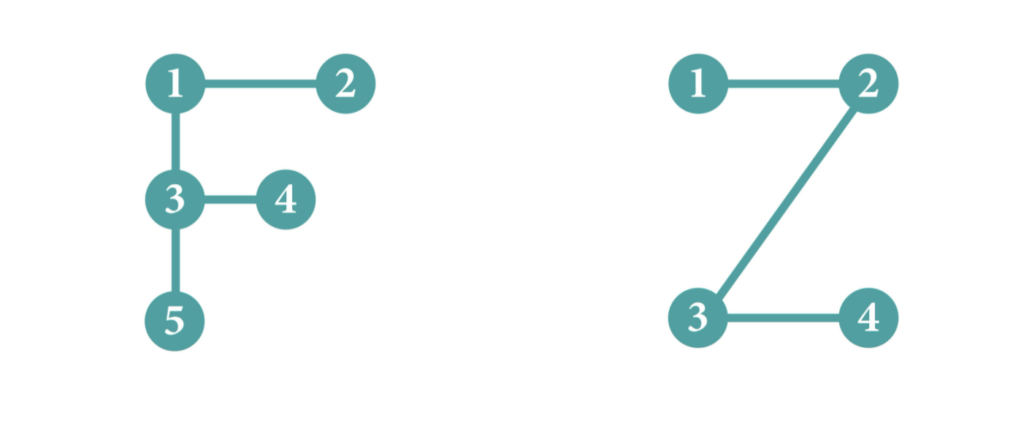
Next, consider the two primary reader flows: The “Z” and the “F” patterns. If your page needs to be copy heavy, the “F” flow provides a natural experience. Most often, visitors will start at the top left of the page, scan right and then down the left side of the page until a component stops their scan.
The “Z” pattern considers how readers engage with a page with more visual elements and less copy. Creating components that alternative styles creates a more pleasant user experience.
Create Consistency
While campaign landing pages are often developed on the periphery of brand work or outside of your website, it shouldn’t be a completely different experience for the user. Successful landing pages account for the entire campaign ecosystem as well as the entirety of the customer journey.
To be clear, campaign landing pages should be consistent with your paid media and your owned assets–your website. We’ve covered the importance of aligning your advertising with your landing page–the same can be said for your website.
Why? Our brains were designed for pattern recognition and we process visuals (i.e. design) much faster than messages. Message alignment is important, but visual consistency instills a sense of confidence and relevancy-removing user dissonance.
When designing your higher ed landing pages, pull in brand guidelines as well as ad design elements. You don’t need to incorporate 100 percent of the ad, but purposeful elements such as images, color palette, button design, etc.
Highlight Benefits
Humans naturally seek confirmation. When we’ve expressed interest in something – let’s say clicking on an ad – we want our rationale for interest to be proven correct.
Part of the confirmation is that the benefit matches the user’s interest. And the quickest way to express the benefit of your product or service is visually. This isn’t to downplay the importance of copy, it is just that our brain can process visual cues much quicker – meaning emotions, brand cues and end user.
Typically the hero image is the first component a user experience. The hero image should be attention-grabbing but not at the sacrifice of clarity. A good test is to remove all copy and see if you can still understand what the page is about.
When it comes to the image, research would suggest that people-focus hero images are more effective than product shots or illustration. The use of real people tends to be more memorable and elicit emotion more effectively. Start with emotions and map them to the aspirations of your audience.
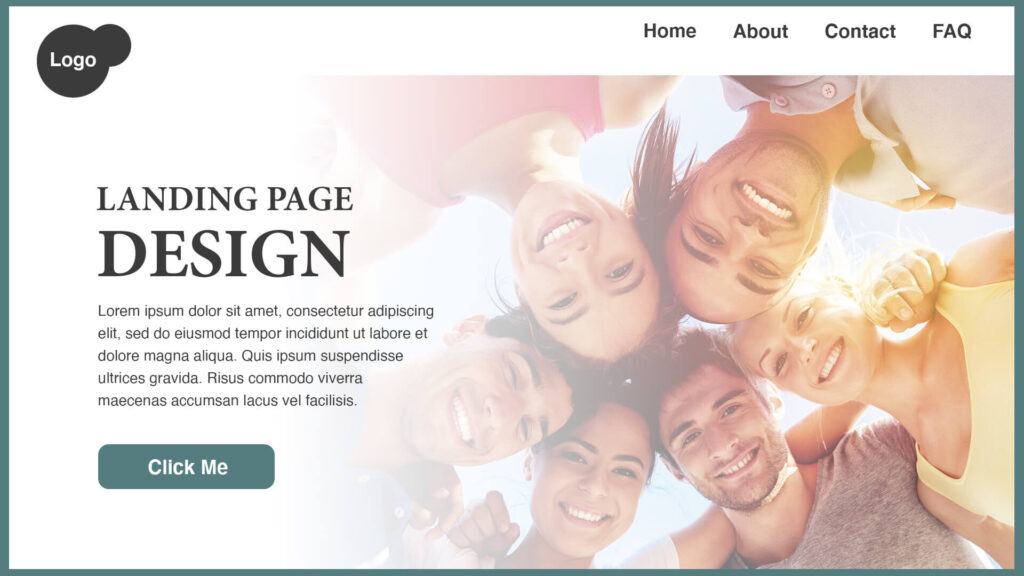
Optimize for Attention
When it comes to designing for action, designers have a few tools that create a direct path to what we want the user to do. The first is to use colors in a way that calls attention to elements. For example, to highlight buttons use a mix of contrasting colors. In the example below, we’ve chosen a color that contrasts with the overall theme of the landing page to quickly draw attention to it.

Negative space can also create an environment that forces focus on one specific element. Negative space is a useful tool for benefit-driven copy and buttons. Almost immediately a visitor to the page is pulled to the copy on the left.

Finally, use images to drive the users’ attention. Research using eye-tracking technology routinely shows the impact of the human gaze. We tend to follow eye lines and direct our attention in reference to where someone is looking. The strategic use of a person’s gaze can place the focus on a button or line of copy.
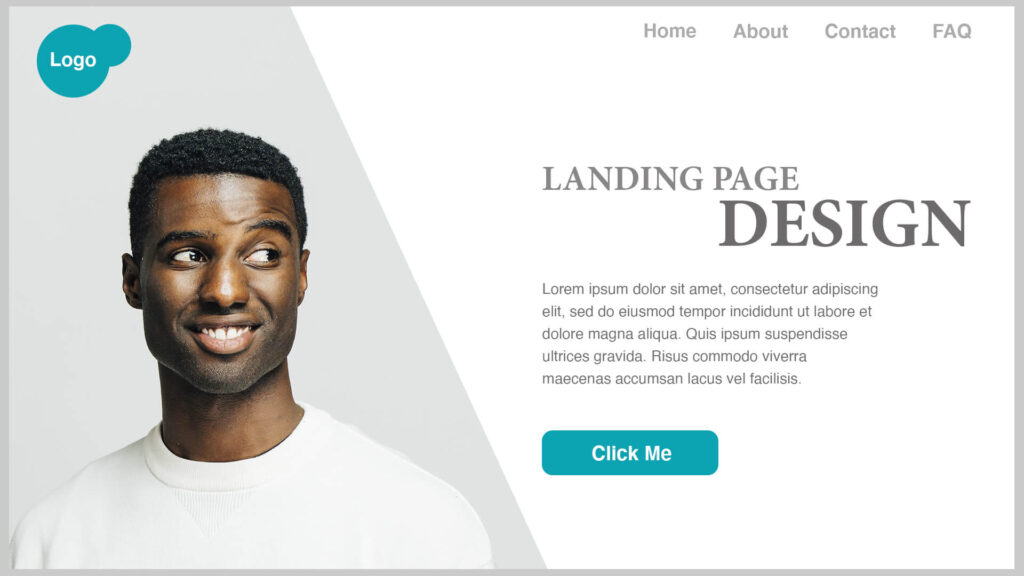
Build Trust
Social proof is one of the most vastly studied heuristics – or cognitive biases. Humans have a powerful desire to fit in and the quickest way to learn a behavior is to observe the crowd. Testimonials on landing pages is a common but effective practice.
When planning on placement of testimonials remember that they are important for reinforcing a user’s beliefs about a product or service. To help, include personal details that make the message more relatable and credible. Reflex words and emotions that are natural and mirror your audience’s.

Set a Strong Foundation from the Beginning
A few additional housekeeping items to ensure you’ve built a solid foundation for your users. Make sure the page is mobile friendly. This means cut down on extraneous copy and make sure what’s above-the-fold is a positive user experience. Second, make sure your page load times are short. A few things you can do to keep your load times down are to optimize your images and video for the web, cache your web pages and minimize your pages code. Use Google’s Test My Site tool to find out how your page scores.
Finally, don’t reinvent the wheel. If you’ve found success previously, pull in past learning or design elements. A new campaign doesn’t necessarily mean you need a newly designed landing page.
Related Insights
Tags
The post 6 Principles to Help you Design the Perfect Higher Ed Landing Page appeared first on GMB.
]]>

